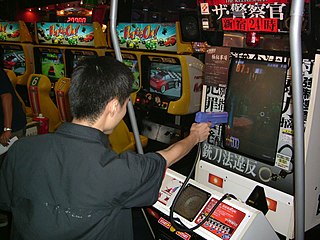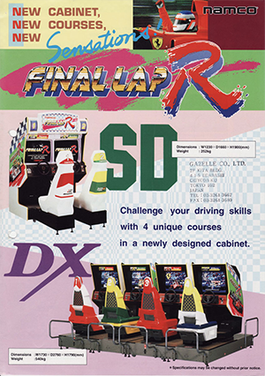
The Neo Geo, stylized as NEO•GEO and also written as NEOGEO, is a ROM cartridge-based arcade system board and fourth-generation home video game console released on April 26, 1990, by Japanese game company SNK Corporation. It was the first system in SNK's Neo Geo family.

An arcade video game takes player input from its controls, processes it through electrical or computerized components, and displays output to an electronic monitor or similar display. All arcade video games are coin-operated or accept other means of payment, housed in an arcade cabinet, and located in amusement arcades alongside other kinds of arcade games. Until the early 2000s, arcade video games were the largest and most technologically advanced segment of the video game industry.
The fifth generation era refers to computer and video games, video game consoles, and handheld gaming consoles dating from approximately October 4, 1993, to March 23, 2006. The best-selling home console was the Sony PlayStation, followed by the Nintendo 64 and Sega Saturn. The PlayStation also had a redesigned version, the PSone, which was launched on July 7, 2000.

A ROM image, or ROM file, is a computer file which contains a copy of the data from a read-only memory chip, often from a video game cartridge, or used to contain a computer's firmware, or from an arcade game's main board. The term is frequently used in the context of emulation, whereby older games or firmware are copied to ROM files on modern computers and can, using a piece of software known as an emulator, be run on a different device than which they were designed for. ROM burners are used to copy ROM images to hardware, such as ROM cartridges, or ROM chips, for debugging and QA testing.

Daytona USA is an arcade racing game developed by Sega AM2 and released by Sega in March of 1994. Inspired by the popularity of the NASCAR motor racing series in the US, the game has players race stock cars on one of three courses. It was the first game to be released on the Sega Model 2 arcade system board. Daytona USA is one of the highest-grossing arcade games of all time.

Virtua Racing or V.R. for short, is a Formula One racing video game developed by Sega AM2 and released for arcades in 1992. Virtua Racing was initially a proof-of-concept application for exercising a new 3D graphics platform under development, the "Model 1". The results were so encouraging that Virtua Racing was fully developed into a standalone arcade title.

Virtua Cop 2 is a light gun shooter arcade game, released in 1995 and developed internally at Sega by their AM2 studio. It was ported to the Sega Saturn in 1996, PC in 1997, and Sega Dreamcast in 2000. It was bundled with Virtua Cop in Virtua Cop: Elite Edition for PlayStation 2 in 2002.

Virtua Striker is a series of association football sports video games released by Sega for arcades. Originally developed by Sega AM2 from 1994 to 1999, the series moved to Amusement Vision with Virtua Striker 3, but it later moved to Sega Sports Design R&D Dept. with Virtua Striker 4.

Virtua Fighter 2 is a 1994 fighting video game developed by Sega. It is the sequel to Virtua Fighter (1993), and the second game in the Virtua Fighter series. It was created by Sega's Yu Suzuki-headed AM2 and was released for arcades in 1994. Ports were released for the Sega Saturn in 1995 and Microsoft Windows in 1997.
A dedicated console is a video game console that is limited to one or more built-in video game or games, and is not equipped for additional games that are distributed via ROM cartridges, discs, downloads or other digital media. Dedicated consoles were popular in the first generation of video game consoles until they were gradually replaced by second-generation video game consoles that use ROM cartridges.

Virtua Fighter 3 is the sequel to 1994's Virtua Fighter 2 and the third fighting game in the Virtua Fighter series, developed and published by Sega in 1996. It was the first arcade game to run on the Sega Model 3 system board.

Puyo Puyo 2 is a 1994 puzzle video game developed and published by Compile. It's the second installment in the Puyo Puyo series and the sequel to Puyo Puyo (1992).
Virtua Fighter is a series of fighting games created by Sega AM2 and designer Yu Suzuki. The original Virtua Fighter was released in December 1993 and has received four main sequels and several spin-offs. The highly influential first Virtua Fighter game is widely recognized as the first 3D fighting game released.

Ridge Racer is a 1993 racing video game developed and published by Namco. It was released initially on the Namco System 22 arcade system board and ported to the PlayStation console in 1994. It is the first title in the Ridge Racer series released for arcades and home consoles.

Alpine Racer is a racing sports video game developed and published by Namco for arcades. It had a limited release in December 1994, followed by a wide release in July 1995. It ran on the Namco System 22 arcade hardware.
The 1990s was the third decade in the industry's history. It was a decade of marked innovation in video gaming. It was a decade of transition from sprite-based graphics to full-fledged 3D graphics and it gave rise to several genres of video games including, but not limited to, the first-person shooter, real-time strategy, survival horror, and MMO. Arcade games, although still very popular in the early 1990s, began to decline as home consoles became more common. The fourth and fifth generation of video game consoles went on sale, including the Sega Genesis, Super Nintendo, Sega Saturn, PlayStation, Nintendo 64, Game Boy Color and the Sega Dreamcast. Notable games released in the 1990s included Super Mario World, Sonic the Hedgehog, Street Fighter II, Mortal Kombat, Tekken 3,Doom, Wolfenstein 3D, Quake, Duke Nukem 3D, Final Fantasy VII, Unreal Tournament, Star Fox, Half-Life, Grand Theft Auto, Super Mario 64, Pokémon Red and Blue, NBA Jam,Daytona USA, GoldenEye 007, System Shock 2, Civilization,Ridge Racer, Sonic Adventure, Gran Turismo, Super Mario Kart, Pokémon Gold and Silver,Castlevania: Symphony of the Night, Super Metroid, Silent Hill, Dead or Alive 2, The Legend of Zelda: Ocarina of Time, Crash Bandicoot, Spyro The Dragon, Fallout, Metal Gear Solid, Diablo, Virtua Fighter, Tomb Raider,Sega Rally Championship, Wing Commander,Super Smash Bros, Secret of Mana,Thief: The Dark Project, Age of Empires, Nights into Dreams, Panzer Dragoon, Gunstar Heroes, EverQuest, Chrono Trigger, Battletoads, Worms, Myst, Micro Machines, Streets of Rage 2,Baldur's Gate,Donkey Kong Country, Wipeout, The Legend of Zelda: A Link to the Past, Super Mario Land 2: 6 Golden Coins,Lemmings, EarthBound, StarCraft, Banjo-Kazooie, PaRappa the Rapper, Resident Evil, Tony Hawk's Pro Skater, Soulcalibur, Command & Conquer, and Dance Dance Revolution.

Sega Sports Research and Development or Sega Sports R&D was a development division of the Japanese video game company Sega. It was previously known as Smilebit, one of nine semi-autonomous studios which Sega established in 2000. Smilebit was previously known as R&D6 or AM6 which itself was mainly based on Sega PC. Smilebit was known for its sports simulation titles, as well as Jet Set Radio. When Sega started releasing games for other platforms, Smilebit began developing games for the Xbox, with Jet Set Radio Future, Panzer Dragoon Orta and GunValkyrie. Smilebit was led by Shun Arai as president and Takayuki Kawagoe as director. Kawagoe became president of Smilebit in 2003.

Final Lap R is a racing arcade game which was released by Namco in 1993. It is the fifth game in the Final Lap series, and was licensed by FOCA to Fuji Television. Like its predecessors, it allows up to eight players to play simultaneously when four two-player cabinets are linked together - and it also features four new tracks set in Germany, Hungary, Belgium and Brazil.

Rail Chase 2 is a rail shooter video game developed and published by Sega for the arcades in 1994, and the sequel to Rail Chase.

Super Sidekicks 3: The Next Glory is a 1995 soccer arcade video game developed and published by SNK. It is the third installment in the Super Sidekicks series, succeeding Super Sidekicks 2: The World Championship (1994). Featuring an arcade-style approach to soccer like its predecessors, the game allows players to choose any of the available game modes to compete with AI-controlled rivals or other human players with their preferred team. Though first launched for the MVS hardware, the title was ported for Neo Geo AES and Neo Geo CD, in addition of being re-released through compilations and download services for various consoles. It proved popular among players and garnered positive reception from critics, however most reviewers noted that it felt more an update than a true successor to Super Sidekicks 2. It was followed by The Ultimate 11: SNK Football Championship in 1996.
















